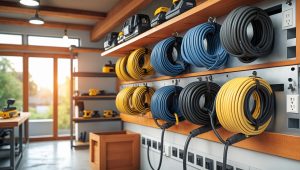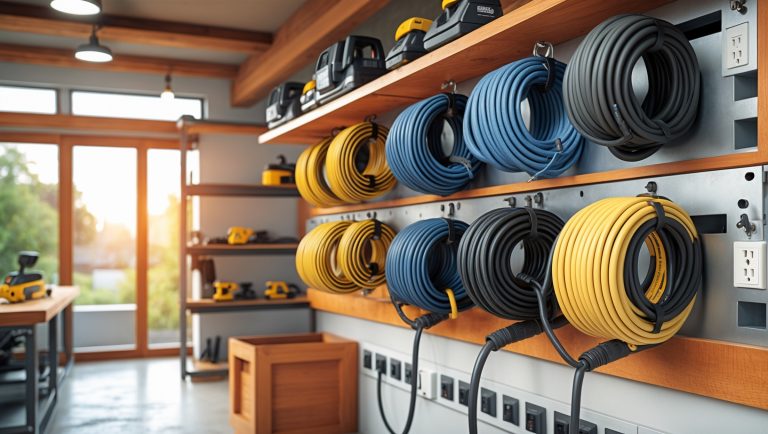Introduction: Why Every DIYer Needs an Electrical Tester
Whether you’re fixing a faulty outlet, installing a new light fixture, or troubleshooting a mysterious power outage, electrical testers are indispensable tools for any homeowner who tackles DIY repairs. The world behind your home’s walls is alive with electricity, and without the right tester, even a simple swap of a wall switch can become dangerous—or frustrating. But with so many types of voltage and continuity testers available, choosing the right one, using it safely, and maintaining it for reliable results isn’t as straightforward as grabbing the first tool off the shelf. This comprehensive guide unpacks everything you need to know about selecting, using, and maintaining electrical testers—specifically voltage and continuity testers—so you can work confidently and safely on your home’s electrical systems. We’ll cover key features to compare, rookie mistakes to avoid, maintenance best practices, and step-by-step instructions for common DIY scenarios. By the end, you’ll have the practical know-how to simplify repairs, prevent costly errors, and ensure your home’s electrical upgrades are safe and reliable.
Understanding Electrical Testers: Types and Functions
What Is an Electrical Tester?
An electrical tester is a handheld device designed to detect, measure, or verify the presence (or absence) of electrical voltage or continuity in a circuit. The two most crucial testers for home DIYers are voltage testers and continuity testers. Each serves a unique role in diagnosing and resolving electrical issues.
Voltage Testers: Detecting Live Circuits
- Non-Contact Voltage Testers (NCVT): Detect AC voltage without touching bare wires. Ideal for quick checks—just bring the tip near an outlet or wire, and the tester lights up or beeps if voltage is present.
- Contact Voltage Testers: Require you to touch the probe to the conductor. Some are simple (neon light testers); others are more advanced (solenoid or electronic testers).
- Multimeters: The Swiss Army knife of testers—measure AC/DC voltage, continuity, resistance, and more. Digital models (DMMs) are preferred for home use due to their accuracy and ease of reading.
Continuity Testers: Ensuring Complete Circuits
- Simple Continuity Testers: Battery-powered device with a probe and a lead. Confirms if a complete path exists in a wire or circuit. If the circuit is complete, the tester lights up or buzzes.
- Multimeters: Most digital multimeters have a dedicated continuity mode—when the circuit is continuous, you’ll hear a beep.
How to Choose the Right Electrical Tester for Home Use
Key Factors to Consider
- Intended Tasks: Are you mostly checking for live wires, or will you be diagnosing deeper electrical issues?
- Safety Features: Look for testers with insulated probes, sturdy casings, and clear voltage ratings. CAT ratings (e.g., CAT II, CAT III) indicate protection levels against surges.
- Ease of Use: Features like audible indicators, large digital displays, and ergonomic grips make a big difference, especially for beginners.
- Accuracy: For troubleshooting or repairs, accurate readings prevent costly mistakes. DMMs with auto-ranging functions are particularly user-friendly.
- Budget: Basic voltage testers start under $15, while advanced multimeters can exceed $60. For most DIYers, a reliable mid-range DMM and a non-contact voltage tester cover all needs.
Comparing Popular Home Tester Models
- Klein Tools NCVT-2: Dual-range non-contact tester, detects standard and low voltages. Pocket-sized and robust—ideal for beginners.
- Fluke 101 Digital Multimeter: Compact, reliable, measures AC/DC voltage, continuity, and resistance. Considered a gold standard for accuracy and durability.
- Gardner Bender GVD-3504: Simple, affordable contact voltage tester—useful for quick outlet or switch checks.
Beginner Mistakes to Avoid with Electrical Testers
1. Not Testing the Tester
Always verify your tester is working before and after use. Use a known live outlet or battery to check. This step prevents false negatives, which can be dangerous.
2. Using the Wrong Tester for the Job
Never use a continuity tester or DMM in continuity mode on a live circuit—it can damage the tester and pose a shock hazard. Non-contact testers are not suitable for measuring continuity or voltage levels.
3. Ignoring Safety Precautions
Always turn off breakers before probing outlets or fixtures. Wear insulated gloves, and never touch metal parts of the probes during testing.
4. Misinterpreting Results
Non-contact testers are convenient but can give false positives near static or poorly grounded circuits. Confirm with a second tool if results seem odd.
5. Skipping Maintenance
Dead batteries, damaged probes, or cracked casings can make testers unreliable or unsafe. Regularly inspect and maintain your tools (see below for details).
Step-by-Step Guide: Using Voltage and Continuity Testers Safely
Preparing for a Test
- Wear insulated gloves and safety glasses.
- Ensure your tester is rated for the voltage level you expect.
- Verify the tester’s operation on a known live circuit (for voltage) or with a battery (for continuity).
How to Use a Non-Contact Voltage Tester
- Switch the tester ON and confirm it beeps/lights up on a known live outlet.
- Hold the tip near the wire, socket, or switch terminal—do not insert it into the slot.
- If voltage is detected, the tester will beep or illuminate.
- Test both hot and neutral sides for full confirmation.
How to Use a Digital Multimeter for Voltage
- Set the multimeter to the correct voltage range (AC or DC as needed).
- Insert the black lead into COM (common), the red lead into VΩ.
- Touch the probes to the two points you’re testing (e.g., outlet slots).
- Read the voltage. For a standard US outlet, expect ~120V AC.
- Remove probes, turn off the meter, and store safely.
How to Use a Continuity Tester
- Ensure the power is OFF to the circuit (test with your voltage tester first).
- Connect the tester’s leads to both ends of the wire or device.
- If the circuit is complete, you’ll see a light or hear a beep.
- No light/beep indicates an open circuit or break in the wire.
Maintenance Best Practices for Electrical Testers
Routine Care
- Inspect before each use: Look for cracks, frayed wires, loose probes, or corroded battery contacts.
- Replace batteries promptly: Weak batteries give unreliable results.
- Clean contacts: Use isopropyl alcohol and a soft cloth to clean probe tips and battery contacts as needed.
- Store properly: Keep testers in a dry, padded case away from extreme temperatures and direct sunlight.
Calibration and Accuracy Checks
- DIY calibration: For most home testers, periodic checks against known voltages (e.g., standard wall outlet, 9V battery) suffice.
- Professional calibration: For advanced or expensive multimeters, consider annual professional calibration—especially if you rely on them for precise troubleshooting.
When to Replace Your Tester
- Persistent inaccuracies despite fresh batteries and clean contacts.
- Physical damage (cracked case, loose probes) or water intrusion.
- Failed self-test or no response on known live circuits.
Advanced Tips: Getting the Most from Your Electrical Testers
Tracing Dead Outlets and Faulty Switches
Use your non-contact tester to identify where voltage stops along a circuit. For continuity issues, isolate the suspect wire and test end-to-end with your continuity tester. This pinpoints breaks or bad connections.
Testing Extension Cords and Power Strips
- Unplug the cord, then use your continuity tester to check each wire from plug to socket.
- Test for shorts by checking continuity between hot, neutral, and ground—there should be no continuity between these.
Verifying Fixture Installations
After installing a new switch or fixture, use your voltage tester to confirm correct wiring before restoring power. For peace of mind, check continuity across the switch terminals with the switch in both positions (power off).
Common Myths About Home Electrical Testers Debunked
- “All testers are the same.” Not true—each has specific voltage and safety ratings.
- “Non-contact testers are infallible.” They can miss voltage in shielded cables or give false alarms near static.
- “Continuity testers can be used on live circuits.” Never! Continuity tests are for de-energized wires only.
- “Any multimeter will work for home use.” Cheap or unbranded models may be unsafe or inaccurate—always check certifications and reviews.
DIY Electrical Tester Kit: What Should Be in Every Home Toolbox?
- Non-contact voltage tester for quick safety checks
- Digital multimeter for measuring voltage, continuity, and resistance
- Simple continuity tester for rapid circuit checks
- Spare batteries (AAA, 9V, or as required by your devices)
- Insulated gloves and safety glasses
- Small flashlight for dark panels or crawlspaces
- Padded storage case to protect your investment
Conclusion: Mastering Home Electrical Safety and Efficiency
Electrical testers are more than just gadgets—they’re your first line of defense against hazards and your best ally for diagnosing problems quickly and safely. By understanding the differences between voltage and continuity testers, choosing models that fit your needs, and following best practices for use and maintenance, you empower yourself to tackle a wide range of home electrical repairs and upgrades with confidence. Avoiding rookie errors—like using the wrong tester for the job or skipping pre-use checks—can prevent dangerous missteps and costly damage.
Investing in a quality non-contact voltage tester and a reliable digital multimeter pays off not just in safety, but also in peace of mind and project success. Regular maintenance extends the life of your tools and ensures accurate results every time you reach for them. Don’t forget to keep your user manuals handy, periodically test your devices on known circuits, and replace any testers that show signs of wear or inaccuracy.
With the right knowledge and equipment, you’ll find that even complex home electrical tasks become manageable—and you’ll save time and money by spotting issues early. Whether you’re a seasoned DIYer or just getting started, a well-chosen electrical tester kit is an essential investment in your safety and your home’s reliability.









I’m trying to decide between a basic neon light contact tester and a more expensive digital multimeter for casual home repairs. Is a simple tester sufficient for most troubleshooting, or does a multimeter offer important advantages for a DIYer?
A basic neon light tester is handy for quickly checking if an outlet or wire is live, and it’s simple to use for basic tasks. However, a digital multimeter offers much more: it can measure voltage, continuity, and sometimes even resistance and current. If you plan to do more than just check for live wires—like diagnosing circuit problems or checking batteries—a multimeter is worth considering. For occasional, simple jobs, a neon tester is sufficient, but a multimeter gives you greater versatility and safety.
The article mentions both non-contact and contact voltage testers. Is one of these generally more reliable or accurate for figuring out which wire is live when rewiring outlets, or does it mostly come down to user preference?
Contact voltage testers are generally more reliable and accurate for identifying a live wire, as they give a definitive reading when the probe touches the conductor. Non-contact testers are useful for a quick check but can sometimes be triggered by nearby wires or static. For rewiring outlets, using a contact tester is recommended for precise results.
I see the article talks about rookie mistakes when using electrical testers. Can you give some examples of common errors homeowners make with continuity testers specifically, and how to avoid them?
Homeowners often forget to disconnect power before using a continuity tester, which can damage the tester or cause injury. Another common error is not zeroing or testing the tester on a known good circuit before use, leading to false readings. To avoid mistakes, always turn off power at the breaker, double-check the tester’s operation, and ensure the circuit is fully isolated before checking for continuity.